China’s Best-Kept Secret: Spectacular Ethnic Minority Festivals in Guizhou Province
Article and photos
by Lies Ouwerkerk
Senior
Contributing Editor
10/29/2017
In Guizhou Province, Southwest China, you can still set foot in remote mountain villages where people have never seen a Westerner before. Locals will gape at you in utter curiosity as if you just descended from another planet. The wow factor may go both ways, though, as the dazzling sights and sounds of the many festivals taking place in this area, in the period from November to April — the low work season for this largely subsistence farming region — can literally take your breath away.
During these festivals, people from all over the region get together to socialize, eat and drink, entertain and be entertained. There are dance and music performances, water buffalo fights and horse races, and above all, the highly popular competitions between skillful lusheng pipe players who, while playing their bamboo flute, simultaneously perform the most incredible acrobatic acts in front of an enthusiastic audience and a team of judges.
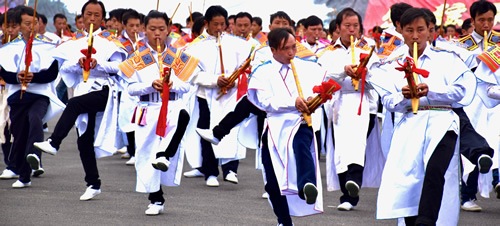
|
Dancing Miao men in a Nankai village festival, playing the traditional lusheng bamboo flute.
|
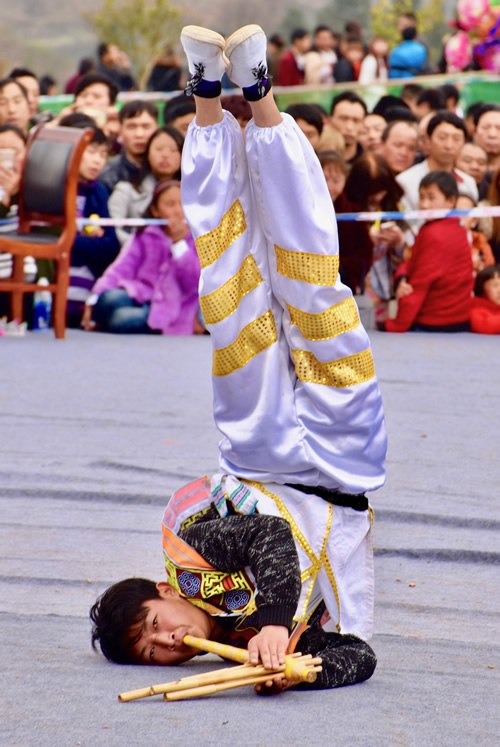
|
|
Lusheng bamboo flute competition.
|
While donning their most spectacular headdresses, embroidered traditional costumes, and silver ornaments (symbols of wealth and beauty), villagers commemorate their heroes and re-enact their revolutionary deeds. The festivities are also a chance for businesses and pop-up vendors to cash in some extra bucks. Yet, the most important aspect of the festivals is the opportunity for the younger generation to meet prospective marriage partners. Each area has its own courting ritual. For instance, girls tie red ribbons around a favorite boy’s lusheng pipe, and boys return a ribbon to the girl they like best.
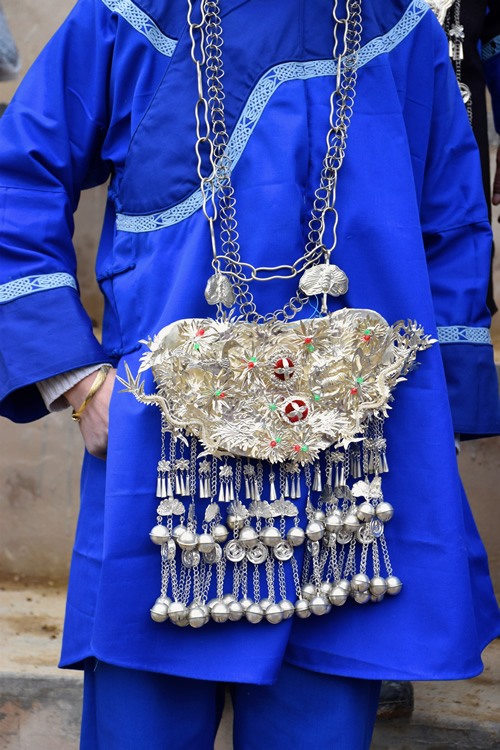
|
|
Silver accessories represent beauty and wealth.
|
The dates of the festivals are never fixed, as organizers have to take into consideration a variety of factors like the Chinese lunar calendar, lucky animal days (e.g. the tiger, bull, dragon and horse are powerful, but snake and pig days need to be avoided at all cost), and lucky numbers (e.g. 8 ensures wealth and prosperity, but 4 means death), to determine the most auspicious festival days. Organizers also need to make sure that potential dates don’t coincide with the festival days of other communities, ensuring that people of one village can travel around to attend other festivals in neighboring villages.
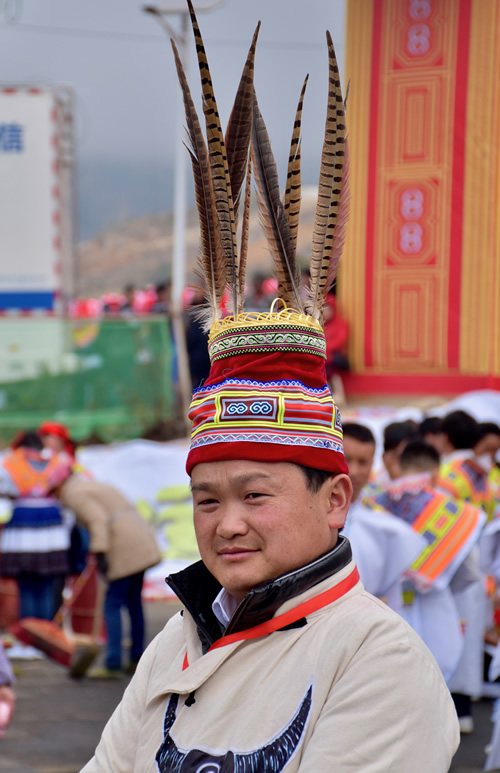
|
|
One of the festival leaders in Nankai village.
|
Ethnic Minority Groups
China is composed of 56 ethnic groups, of which the Han Chinese account for about 92% of the overall population, not only forming the largest ethnic group in China, but in the entire world. The remaining 8% of the Chinese population is made up of 55 minority groups, mostly concentrated in Northern China (e.g. Uygurs) or the Southern provinces of Yunnan, Sichuan, Hunan, and Guizhou.
Every year, each minority celebrates some unique festivals. The Dai Water Splashing Festival in Xishuangbanna, the Sisters Meal Festival in Guizhou, Eid al-Adha in Northwest China, and the Shoton Festival in the Tibetan areas are some of the famous festivals in China that have become well-known tourist destinations. In parts of Guizhou, some villages like Kaili and Langde have been renovated, and are now over-commercialized and exploited by the tourist industry. Their daily dance and music performances attract large crowds of Chinese and overseas tourists. Villagers pose in their best attire for the many clicking cameras, expecting to receive a small monetary remuneration.
However, in the more remote areas of southern Guizhou Province, for long one of China’s poorest and most disadvantaged areas because of its thin limestone soil and economic under-development, adequate transport systems and reasonable hotels are still largely lacking. At these locations, some of the most colorful festivals have stayed under the tourism radar and remain a strictly authentic and local affair.
The Miao
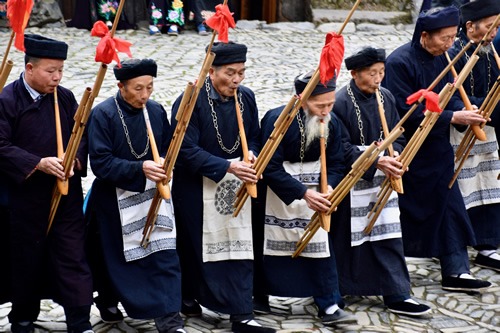
|
Miao elders playing the lusheng flute.
|
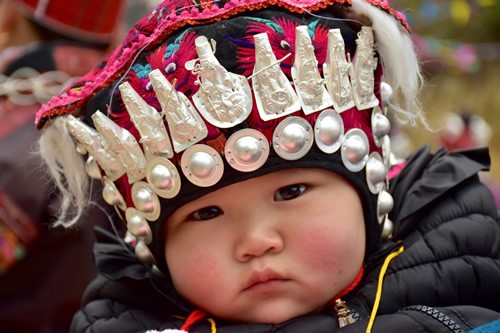
|
|
Miao baby's hat with auspicious silver symbols.
|
The largely animist and shamanist Miao (or Hmong, as they are known internationally) form the largest ethnic group after the Han in Guizhou. Other important non-Han groups in this province are the Buyi, Yi, Shui, and Dong. Mostly rural, they cultivate rice, wheat, barley, beans, corn, and potatoes, as well as rapeseed, tobacco, sugarcane, and sugar beets, mainly for subsistence purposes.
The population of Guizhou still counts for one of the highest rates of illiteracy in the country, but the minorities’ musical qualities as well as their traditional costumes and folk art such as batik, cross-stitch and paper cutting, are quite famous.
Nobody seems to know exactly where the Miao originally came from, but aside from interesting legends (one claims for instance that the Miao come from the eggs of a butterfly), it is generally assumed that they originate from the plains of the Yellow River in the North and gradually fled south after being defeated by Han Chinese troops.
The Miao count many sub-groups, each with a distinct dialect, customs, and costumes. Usually, they have nicknames given to them by the local Han, referring to places they inhabit (Mountain Miao) the women’s attire (Long or Short Skirt Miao), their hairstyle (Side-comb Miao), or the color of their headdress (Black, White, or Red Miao).
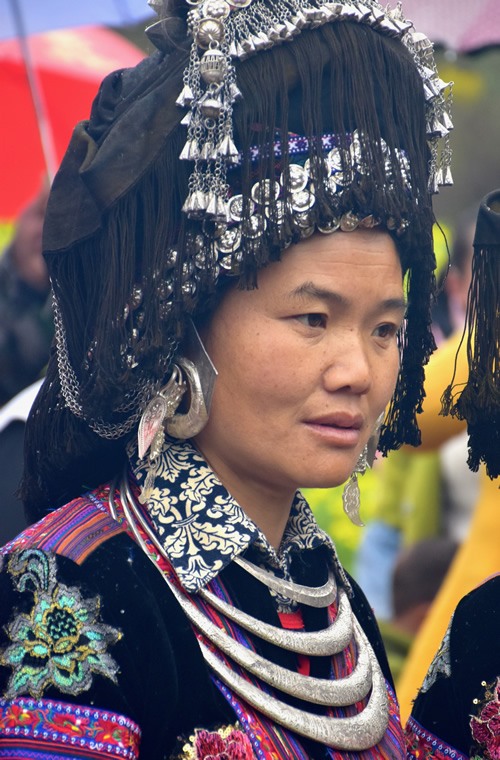
|
Black Miao woman.
|
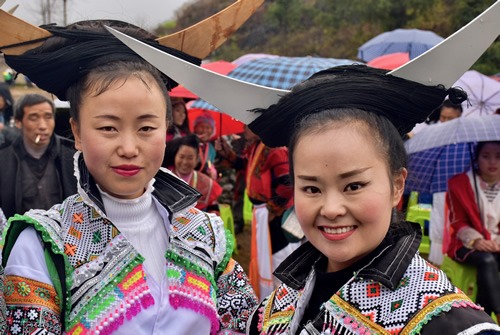
|
|
White Miao women.
|
In Search of the Festivals
In order to find out in which remote villages festivals are taking place, to arrange the logistics of meals and lodgings along the way, and to manage the smaller and often sign-less mountain roads of southern Guizhou, I have secured myself in the province’s capital Guiyang of a Chinese guide, named Chen. He is an affable Chinese Han with a good command of English, familiarity with the various ethnic minorities in the South, and a good network of local contacts in faraway villages (for last-minute updates and directions!). He also owns a decent 4x4 station wagon, needed to tackle the curvy dirt roads in the mountainous areas.
Along the way, we eat simple but tasty meals in little village restaurants and are often the only visitors at the time. We may feast at a market stall selling fresh fruits and vegetables with a small seating area and a two-burner stove at the side, where the vendor quickly whips up a delicious hotpot accompanied by rice from a bamboo steamer; other times we may visit a make-shift eatery in a villager’s garage, with some chairs around a woodstove where we can stay warm during the often drizzly and chilly early days of March.
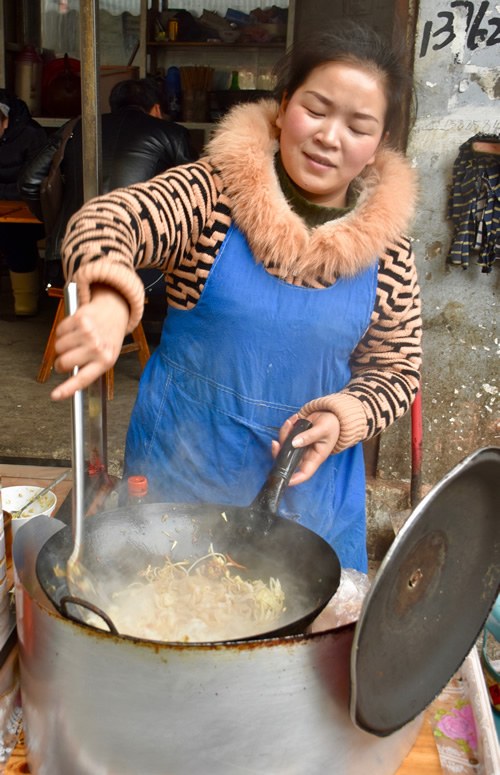
|
|
Lunch at a local market.
|
Chen has designed our itinerary in such a way, that each day when evening draws close, we arrive at a reasonably sized town to spend the night in a good and clean hotel.
Only once do we have no other choice but to settle for a less adequate lodging. The only seemingly decent hotel in the Taijiang area has no functioning showers, compounded by an unexpected power outage. But that proves manageable for one night, especially since the jolly owner of the hotel makes up for the shortcomings by providing numerous extra blankets, and inviting us to bake potatoes in her woodstove over a chat and locally brewed rice liquor — a priceless experience with lots of laughter!
That traditional hospitality and generosity is also demonstrated during the assorted festivals. At the Tiaohua Festival of the Small Flowery Miao in Nankai village, celebrated on the 15th day of the second lunar month, attractive young women are positioned at several points near the entrance to the festival grounds to catch every guest intending to pass the gates. They invite them to drink liquor from the horns of a water buffalo before letting them join the party, and since refusing to drink is considered very offensive, people usually surrender with a smile to a gulp or two.
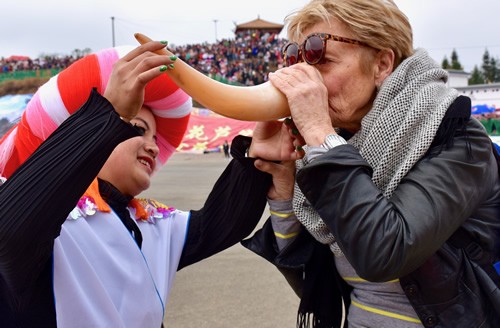
|
The author drinking offering locally brewed liquor from the horn of a water buffalo: a traditional sign of hospitality.
|
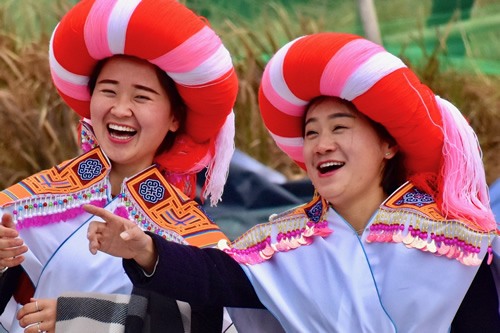
|
Miao women enjoying the festival in Nankai village.
|
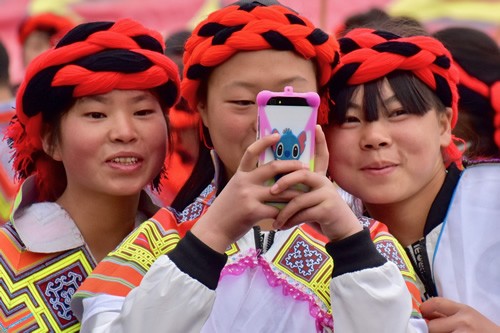
|
At the Tiaohua Festival: who is photographing whom?
|
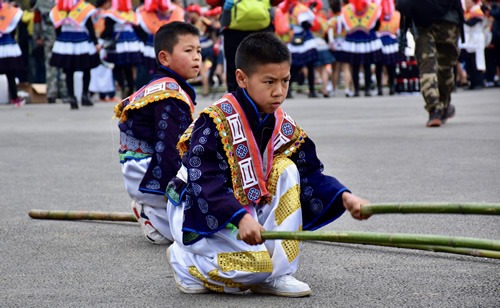
|
|
Pole jumping is one of the many festival traditions.
|
Reaching our intended destinations remains a matter of "trial and error." There are not many signs along the dirt roads of southern Guizhou, and we often have to stop to ask directions when chancing upon a shepherd or villagers heading for a local market.
Once, we are told to cross a wooden suspension bridge that is off-limits to cars. So we have to park the car at one side of the river and walk cautiously over the wobbly bridge to get to the other side. We must then convince some passing motorcyclists to transport us to the village where a Lusheng festival is taking place in exchange for a couple of Chinese yen.
The final destination proves to be a truly authentic find: a tiny village untouched by tourism, with a circular square for the festivities, surrounded by typical wooden houses dotted against the mountains, shy but curious villagers decked in their most splendid traditional outfits, and customs and rituals where traditional instruments like drums and flutes are played by the most revered elders. To watch such a scene from the best seats in town, the rooftops, is a surreal and unforgettable experience.
Other Ethnic Minorities
Just when I start wondering where ethnic groups other than the Miao might live, we pass the pretty village of Beizhai in the Anshun area, situated amid beautiful rapeseed fields. Its history dates back to the Ming dynasty when the emperor established military garrisons for Han soldiers to keep federal control in Guizhou and calm down the uprisings of the various ethnic groups. Wives would follow their husbands, and some families would eventually stay on after completion of military service. Other Han Chinese, in search for new land, would also venture to the region. The practice of Dixi, or "ground opera" using painted wooden masks on the forehead and recreating ancient military stories of the Old Han troops, is still alive and well in this part of Guizhou.
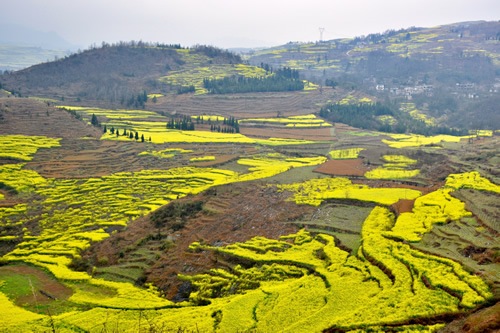
|
Rapeseed fields in Guizhou Province in early March.
|
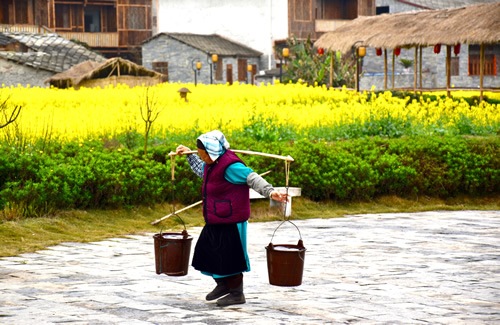
|
Old Han woman in Beizhai.
|
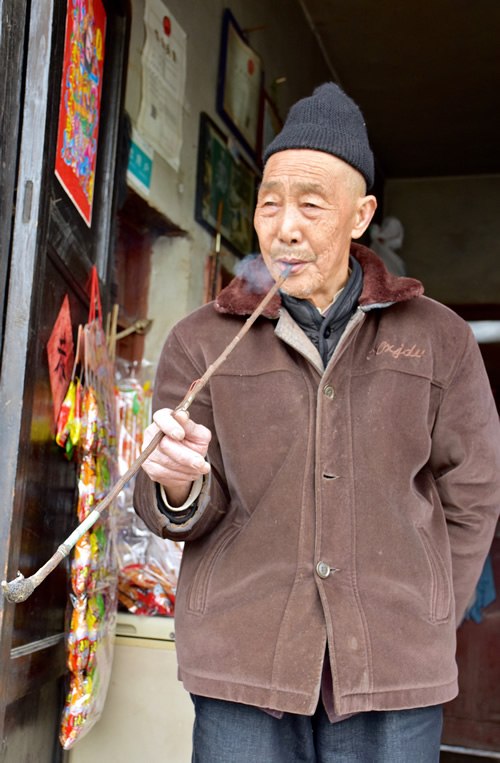
|
Pipe smoking old Han man in Beizhai.
|
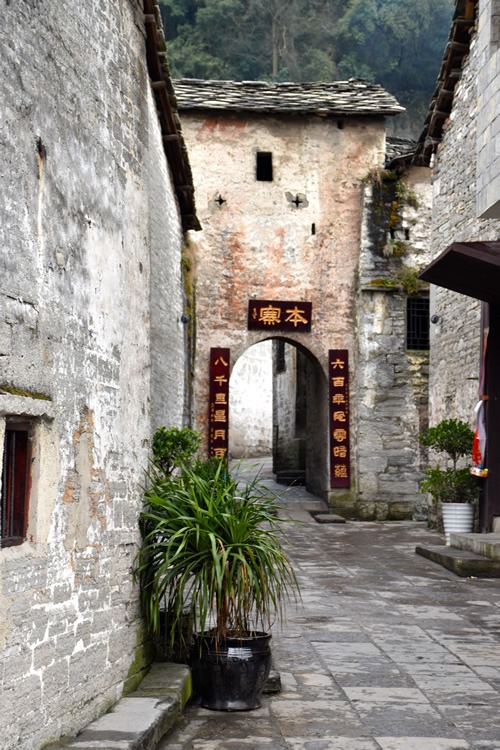
|
|
Village of Beizhai.
|
In the area of Rongjiang, we visit a mountain village of the Dong, famous for their singing and imitating sounds of nature (e.g. water, trees, birds). The village has pebbled pathways along decorated wooden houses, a huge drum tower (used for calling villagers to a gathering), fir-shaped like a pagoda, and roofed, covered bridges — all distinct architectural features of the Dong cultural landscape.
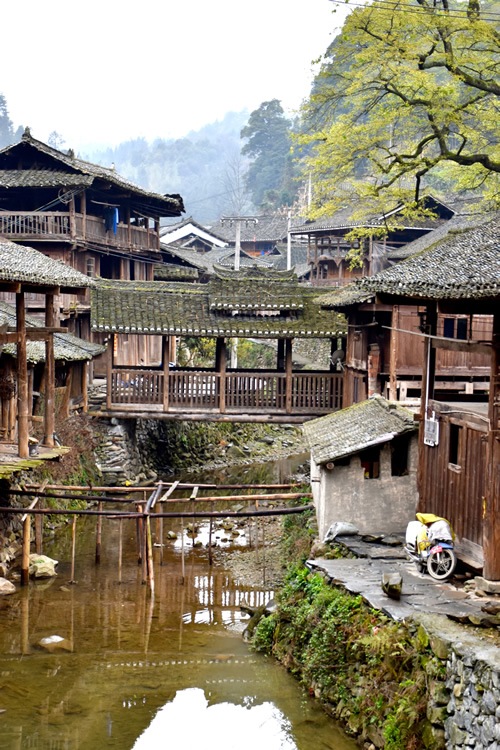
|
|
Wooden houses and covered bridge in a Dong village.
|
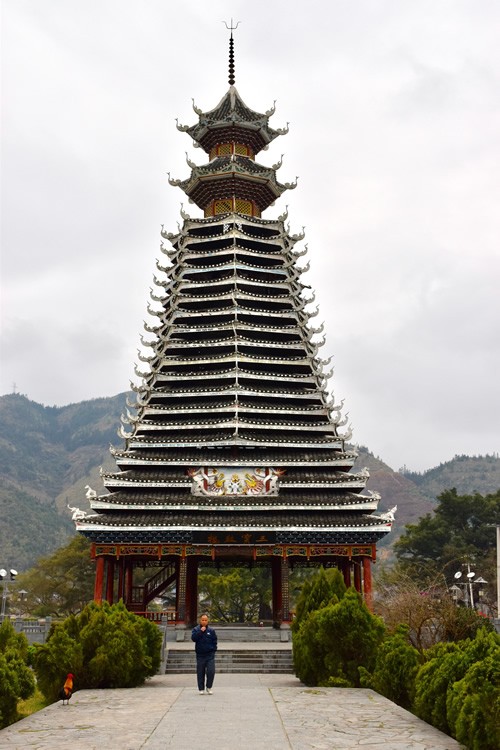
|
|
A Dong drum tower.
|
As we have seen in other hamlets along the road, wedding preparations are here underway in various streets of the village, on apparently another auspicious day. Clusters of men are preparing large amounts of food amid a bunch of slaughtered pigs whose intestines are fed to fish in a nearby pond. Women are in charge of the many dishes, enough to serve the whole village community during three days of feasting.
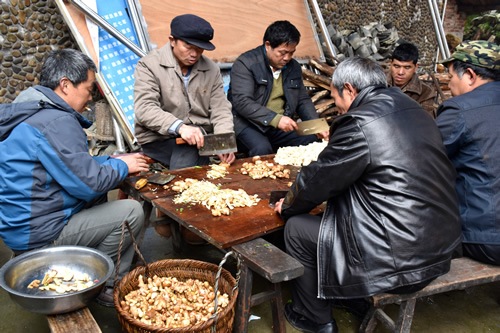
|
|
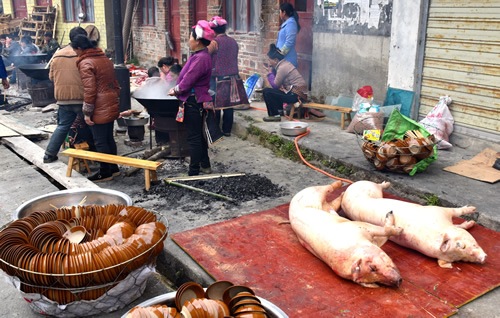
|
|
Wedding preparations in the streets of a Guizhou hamlet.
|
Back to Modern-Day Life
At the end of our road trip through the hard-to-access ethnic regions of Southeastern Guizhou Province, Chen drops me off at the railroad station of Rongjiang, one of the five smaller stations on the ambitious Guiyang-Guangzhou High-Speed Railway (HSR), which opened at the end of 2014. This bullet train service reduces an originally 20-hour rail journey between the two major cities to about 5 hours by cutting right through the limestone peaks of this region. Because of the 238 tunnels dug for this route, it sometimes feels as if you are traveling on a subway. But when in sight, the views of the karst landscapes around Yangshuo and the terraced fields of Longji are truly breathtaking.
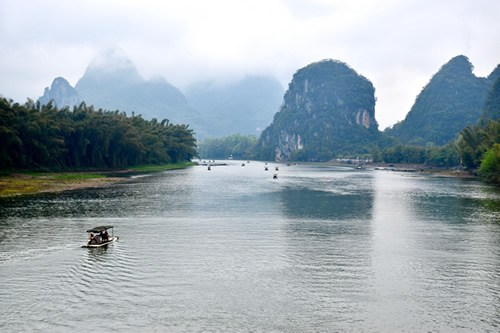
|
|
Karst Mountains around Yangshuo.
|
It is a big leap from the ancient way of life in Guizhou Province to the more modern and prosperous Guangdong Province further east, and it takes some mental effort on my part to comfortably find my way back to the airport along the giant skyscrapers of futuristic Guangzhou.
Lies
Ouwerkerk is originally from Amsterdam,
The Netherlands, and currently lives in Montreal,
Canada. Previously a columnist for The Sherbrooke
Record, she is presently a freelance writer and
photographer for various travel magazines.
|
